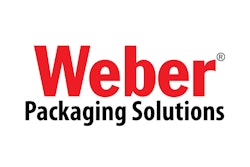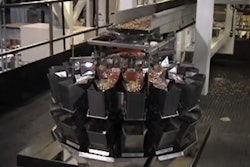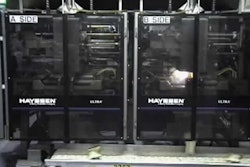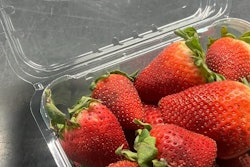Purchasing seven thermal-transfer label printers and four print-and-apply machines represented a considerable investment for Jeffersonville, IN-based cabinet maker Kitchen Kompact. Unlike many companies that purchase packaging machinery, Kitchen Kompact bought the units two years ago without a definitive return-on-investment timeframe.
“We can’t really justify the equipment purchase in terms of spending a certain amount of money and expecting to get x amount in return,” explains Chris Gahm, a plant purchaser. “Our intention was to provide a service for our customers.
“No company demanded we apply a bar-code label to our cabinet cases, but we believe that as customers like Menards continue to use advanced technology, they’ll be able to take advantage of bar codes for inventory purposes. We didn’t want to reach the point where customers would have to tell us to use such labels. Instead, we took a proactive approach by using labels.”
That move, says Gahm, earned the company praise from both its homebuilder and retail supply-store customers. Labels are printed and either manually or machine-applied on 10 packaging lines using equipment supplied by Weber Marking Systems (Arlington Heights, IL). The Model 5100 print-and-apply machines are mounted directly above the conveyor on each of the lines. The eleventh machine is used in an office, primarily to print short-run accessory items such as shelf kits, or used as a spare machine.
Manual process
Packaging is mostly done by hand. Workers assemble a cabinet and place it face up on an approximately 50’-long conveyor. Doors, hinges, drawers, and shelves are assembled into the cabinet on the conveyor, which eventually carries the product downstream. There, three operators are positioned to handle packaging-related tasks.
The first worker erects knocked-down, end-loading corrugated cases and tapes shut one end before positioning a case on the end of the conveyor. Cases fit specific cabinet sizes. There are more than 500 cabinet varieties, which range up to 48” wide x 30” high x 23” deep.
The second worker slides the cabinet into the open box. On most lines, the worker types in the cabinet size and style on a PC at his workstation. The PC relays that data to the printer on that line, and the label is printed. The 5100 print-and-apply units are outfitted with a Zebra (Vernon Hills, IL) Model 172 printer. The seven machines that don’t apply labels use Weber’s 20-Series thermal-transfer printers.
Weber customized its Legitronic® software to accommodate Kitchen Kompact’s hundreds of SKUs, developing a label format for each item with the proper UPC bar code, product name, date code, and assembly-line number. That information is accessible through the different PCs.
Back on the line, the boxed cabinet is conveyed another 6’ or so where a photoeye senses the incoming pack. That triggers the print-and-apply machine to peel the printed pressure-sensitive label from its liner and retain it by vacuum on a tamp pad, or manifold, on a 36” applicator arm. The arm is mounted to the 5100’s custom-designed H-base stand that accommodates the large cases.
The applicator arm descends between 12” and 14”, depending on the pack size. It’s equipped with a proximity sensor that automatically adjusts the length of each stroke based on case size. Vacuum is released, and the arm tamps the label onto the top or face of the case. On lines where production is less frequent, Kitchen Kompact workers hand-apply a label to the top of the box.
The applicator arm then retracts to its original position, and the labeled case is conveyed a few feet so that the third operator can fold the open end flaps and tape-seal the box. The operator then places the boxed cabinet on a metal platform that carries it along a suspended conveyor nearly 400 yards to the company’s warehouse. Cases are not palletized, but rather loaded onto a truck for delivery to warehouses or builders.
Learning to label
“Before we added the Weber machines, we weren’t doing any labeling,” says Gahm. “We used black markers and rubber stamps for identification of our product. It worked fine for us, but we looked down the road and knew our customers were eventually going to demand more identification. We create the bar-coded labels and tell customers what the numbers designate.” Besides the bar code, an example of printed copy would be “Chadwood 36W,” which indicates the style is Chadwood in a 36”-wide wall cabinet.
How did Kitchen Kompact make its equipment selection? Gahm recalls attending Pack Expo ’98 in Chicago with his brother, John, in production. Gahm says that they attended the show “because we needed to get our name out to vendors so that they would come to our facility and see our different line set-ups.
“At that time,” he continues, “we had no idea about bar-coding or case-labeling equipment, so we looked at equipment at the show and started gathering ideas. We walked into booths and asked vendors to send a local rep to our plant, because our needs and our layout are difficult to explain in words. We wanted someone to come in, see our set-up and be able to say this is what they think will help us.
“Weber’s Bonnie Hoffman visited the Jeffersonville plant with her district sales manager Rhett Campbell, and they were the first to respond,” Gahm continues. “We showed them how different each of our lines was. They surveyed our operation and made specific recommendations.”
Gahm says he made it clear to all prospective vendors that “we weren’t going to hire an extra employee to apply the label. And,” he adds, “we weren’t going to make any drastic changes to our production process. We wanted the simplest set-up on our lines as we could, and Weber worked with us to develop the software to let us do that.”
Simplicity was a key concern because Kitchen Kompact is not a high-technology operation. “We were nervous about putting computers on the assembly lines,” Gahm admits. “We explained to Weber how we needed the software to function, and that’s what we got. All the operators need to know is what style and size of cabinet they’re labeling. The system is that simple.”
Since the equipment was installed, Gahm points out that “it’s run well, and their service is excellent. Weber created a partnership with us, and I wouldn’t change a thing about our system.”





























